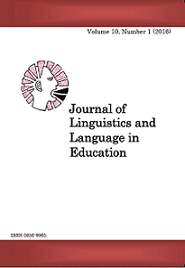Ninogeshe: Strategic Selection of Value Adding Terms in Advertisement and Slogan Creation by Corporations in Dar es Salaam
Abstract
Strategic choice of lexical items constitutes one of tactics that corporate
companies adopt when composing advertisements or creating slogans. The
paper presents a situation in which five corporate companies: Bakhresa Group,
CRDB Bank, Tanzania Telecommunication Corporation Limited, Viettel
Tanzania Public Limited Company (Halotel) and Tanzania Breweries Company
Limited converged in the use of one lexical item -noga in its various
derivations to generate advertisement and slogans for their products. To
establish a historical background of the term -noga and the reasons for this
convergence, the author reviews Bantu language dictionaries and relies on the
information from print press. The findings show that -noga is an old stem
carrying the meanings ô€‚¶ô€Šô€’ô€’ô€‡ô€‚·ô€€ô€€ƒ ô€‚¶ô€–ô€šô€ˆô€ˆô€—ô€‚·ô€€ƒ ô€’ô€•ô€€ƒ ô€‚¶ô€“ô€ô€ˆô€„ô€–ô€„ô€‘ô€—ô€‚·ô€€ƒ ô€Œô€‘ô€€ƒ ô€–ô€ˆô€™ô€ˆô€•ô€„ô€ô€€ƒ ô€€¥ô€„ô€‘ô€—ô€˜ô€€ƒ ô€ô€„ô€‘ô€Šô€˜ô€„ô€Šô€ˆô€–ô€€ƒ
spoken in Tanzania. The game theory which enlightened the interpretation of
the findings is used to explain that, -noga is favourable for advertisements
because it adheres to three characteristics of a potential value adding term.
Linguistically, it is analysable and it respects Bantu language rules;
sociolinguistically, it is popular and suitable to express aesthetical issues like
music and sports, and practically, it has a long and powerful tradition of
ô€ˆô€›ô€“ô€•ô€ˆô€–ô€–ô€Œô€‘ô€Šô€€ƒô€—ô€‹ô€ˆô€€ƒô€‘ô€’ô€—ô€Œô€’ô€‘ô€€ƒô€•ô€ˆô€ô€„ô€—ô€ˆô€‡ô€€ƒô€—ô€’ô€€ƒô€‚¶ô€ô€’ô€™ô€„ô€…ô€Œô€ô€Œô€—ô€œô€‚·ô€€‘ô€€ƒô€€¬ô€—ô€€ƒô€Œô€–ô€€ƒô€•ô€ˆô€†ô€’ô€ô€ô€ˆô€‘ô€‡ô€ˆô€‡, therefore that,
in the light of the choice of this stem among private business corporations,
studies could be extended to other linguistic items on how they can be used to
enhance productivity.
Key words: -noga, game theory, corporation, language
References
References
Adhakari, P. (2018). Effect of Corporate Slogan on Decision Making
of Consumers. SOJ Psychology.
Alkire, S., Bardhan, P. P., Basu, K., Bhorat, H., Bourguignon, F.,
Deshpande, A., Kanbur, R., Lin, J. Y., Moene, K., Platteau, JP.,
Saavedra, J. (2016). Stockholm Statement 15, (November),
􀂲6.
BAKITA. (2015). Kamusi Kuu ya Kiswahili. Dar es Salaam:
Longhorn Publisher Ltd.
Bastin, Y. & Schadeberg, T. C. (n.d.) Bantu Lexical Reconstruction 3.
Basu, K. (2000 ). Prelude to Political Economy: A Study of Social and
Political Foundation of Economics. Oxford: Oxford University
Press.
Bhat, M. A. (2008). Language: The Ultimate Tool of Social Control.
The Interdisciplinary Journal of Linguistics (IJL), 1: 111􀂲118.
Felberg, K. (1996). Nyakyusa-English-Swahili and Swahili-Nyakyusa
Dictionary. Dar es Salaam: Mkuki na Nyota.
Guthrie, M. (1970). Comparative Bantu: An Introduction to the
Comparative Linguistics and Prehistory of Bantu Languages
(3rd Edition). Westmead: Gregg International Publishers
Limited.
Jaeger, G. (2008). Applications of Game Theory in Linguistics.
Language and Linguistics, Compass 2/3: 406􀂲421.
Norbert Mtavangu | 63
Jakobson, R. (1960). Linguistics and Poetics. In T. Seboek (ed). Style
in Language. Cambridge: Mass.
Johnson, F. (1935). Kamusi ya Kiswahili yaani Kitabu cha Maneno
ya Kiswahili: Swahili-Swahili Dictionary. London: Sheldon
Press.
Johnson, F. (1939). A Standard Swahili-English Dictionary. Dar es
Salaam: Oxford University Press.
Kahigi, K. (2008). Kamusi ya Kisumbwa-Kiingereza-Kiswahili na
Kiingereza-Kisumbwa na Kiswahili. Dar es Salaam:
Languages of Tanzania Project.
Knowles, L. L. & Marthur, I. (1995). The Effect of Advertising Slogan
Changes on the Market Values of Firms. Journal of
Advertising Research, 35(1): 59􀂲65.
Kockesen, L. & Ok, E. A. (2007). An Introduction to Game Theory
Retrieved from
http://openlibrary.org/b/OL9836093M/An_Introduction_to_Ga
me_Theory.
Lamtey, G. (2018). Mobile Campaigns Pay off in Scramble for
Customers. The Citizen (15th August 2018).
Leech, G. (1974). Semantics. England Penguin Books Ltd.
Marschak, J. (1965). Economics Language. Behavioral Sciences, 10:
􀂲140
Massamba, D. P. B. (2005). Kamusi ya Ciruuri-Kiswahili -
Kiingereza, Dar es Salaam: Languages of Tanzania Project.
Mdee, J. S. (2008). Msamiati wa Kijita-Kiswahili-Kiingereza na
Kiingereza-Kijita-Kiswahili. Dar es Salaam: Languages of
Tanzania Project.
Mreta, A. Y. (2008). Msamiati wa Kisimbiti-Kiingereza-Kiswahili na
Kiingereza-Kisimbiti-Kiswahili. Dar es Salaam: Languages of
Tanzania Project.
Muzale, H. R .T. (2006). Ikaningambo ya Oruhaya, Kamusi ya
Kihaya,-Kiingereza-Kiswahili. Dar es Salaam: Languages of
Tanzania Project.
Mwanyemba, F. A. (2017). A Comparative Study of Financial
Performance of CRDB and NBC Banks an Application of
Camels Model. ô€€¸ô€‘ô€“ô€˜ô€‘ô€ô€Œô€–ô€‹ô€ˆô€‡ô€€ƒ ô€€°ô€„ô€–ô€—ô€ˆô€•ô€‚·ô€–ô€€ƒ ô€€§ô€Œô€–ô€–ô€ˆô€•ô€—ô€„ô€—ô€Œô€’ô€‘ô€€ô€€ƒ ô€€·he
University Of Dodoma
Rubinstein, A. T. E. (1996). Why are Certain Properties of Binary
Relations Relatively More Common in Natural Language ?
Econometrica, 64(2): 343􀂲355.
| Ninogeshe: Strategic Selection of Value Adding Terms
Rugemalira, J. M. (2009). Kamusi ya Cigogo-Kiswahili-Kiingereza:
Kiingereza-Cigogo-Kiswahili. Dar es Salaam: Languages of
Tanzania Project.
Rugemalira, J. M. (2002). Msamiati wa Runyambo-Kiswahili-
Kiingereza. Dar es Salaam: Languages of Tanzania Project.
Sacleux, C. (1939). Dictionnaire Swahili-Français. Paris: Travaux et
mémoires de l'Institut d'éthnologie.
Sewangi, S. S. (2008). Msamiati wa Kiikizo-Kiingereza- Kiswahili na
Kiingereza, Kiikizo-Kiswahili, Dar es Salaam: Languages of
Tanzania Project.
TATAKI. (2014). TUKI Kamusi ya Kiswahili-Kiingereza, Swahili-
English Dictionary. Dar es Salaam: Taasisi ya Taaluma za
Kiswahili.
Zhang, W. & Grenier, G. (2013). How can Language be Linked to
Economics?: A Survey of two Strands of Research. Language
Problems and Language Planning, 37(3) : 203􀂲226.
Downloads
Published
Issue
Section
License
Copyright © by Department of Foreign Languages and Linguistics, University of Dar es Salaam
All rights reserved. No part of this publication may be reproduced or transmitted in any form or by any means, electronic or mechanical, including photocopying, recording, or any information storage or retrieval system, without permission in writing from the publisher, except for short extracts in fair dealing, for research or private study, critical scholarly review or discourse with an acknowledgement.



